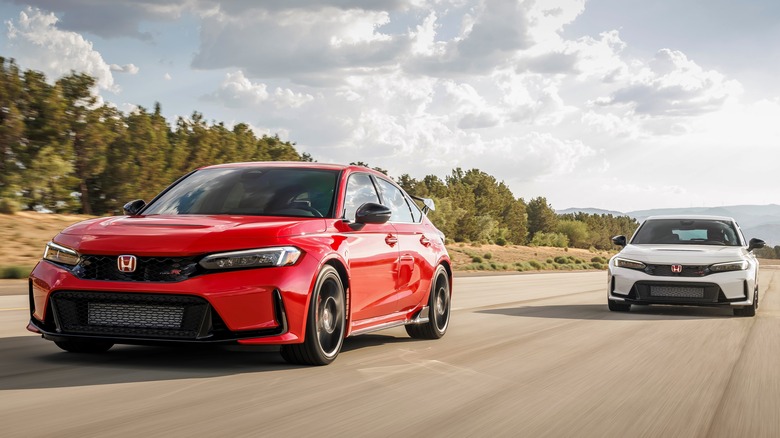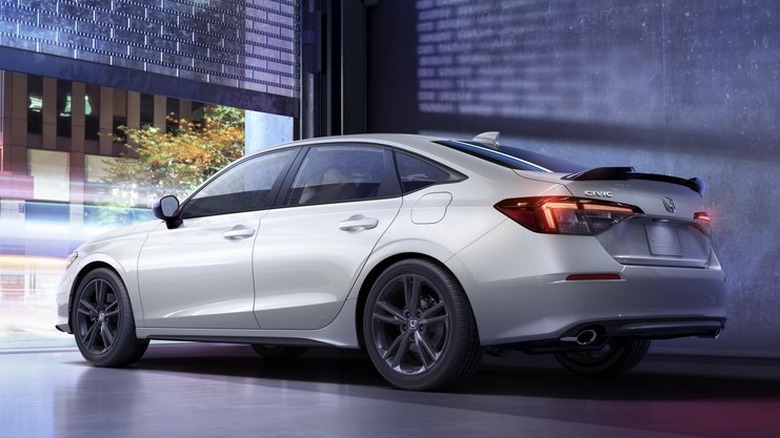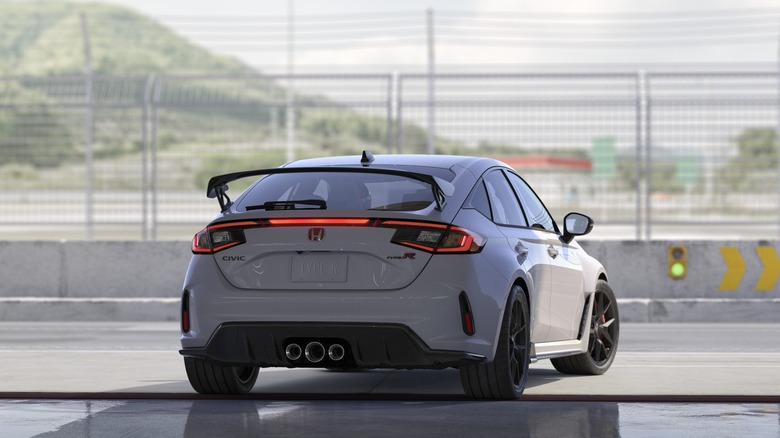What's The Difference Between The Honda Civic Si And Type R?
The Honda Civic is one of the brand's best-selling cars. Since its debut in 1973, Honda has sold over 12 million Civics in North America alone — making it not just a top seller for Honda, but one of the best-selling passenger vehicles in the United States over the last five decades. Part of that success can be attributed to the low cost of entry.
Throughout Honda's history, the Civic has often been one of the least expensive cars in Honda's lineup, and while models like the Fit have undercut it from time to time, the Civic is a stalwart compact car that offers lots of value for the price. What's more, the Civic is known to be fuel efficient and reliable — excellent virtues for a cost-effective vehicle. That said, even those upsides don't tell the Civic's entire story. The Civic is also really fun to drive.
Base models are entertaining enough, but high-performance versions like the Civic Si and the Civic Type R often set the standard for their respective classes. They provide driving fun in an attainable package, complete with all the modern amenities and features you'd expect from a Honda. More than just an entry-level compact sedan, these high-performance versions of the Civic elevate the model name and give it more gravitas amongst enthusiasts. Which one of these pumped-up Civics is right for you?
The Civic Si is the entry-level sporty sedan
The standard Honda Civic is available in multiple configurations. For 2025, it comes standard with a 2.0-liter four-cylinder engine that produces a respectable 150 horsepower and 133 lb-ft of torque. The Civic Si, however, uses a turbocharged 1.5-liter engine that produces 200 horsepower and 192 lb-ft of torque. The Civic comes standard with a continuously variable transmission (CVT), which operates mostly like an automatic (the driver doesn't need to do any shifting), but the Civic Si makes sure you're engaged — it's only available with a six-speed manual transmission.
The newest Civic Si gets a host of updated features for 2025, like a redesigned front end, heated front seats, and retuned suspension. On top of those additions, the Si has bigger brakes than the standard Civic, and all-season performance tires come standard. Want more grip? You can get a set of summer high-performance tires directly from Honda, too. The standard Civic Si is priced at $31,045 (including a $1,095 destination fee), but those extra-sticky tires can be had for just an additional $300. The Civic Si is enthusiast-oriented, but still totally practical with a price tag.
The Civic Type R is the top-of-the-line driving machine
The Honda Civic Type R is the top of the Civic heap: This trim features the maximum horsepower from the model lineup, along with all sorts of performance upgrades over the standard model. Under the hood, there's a turbocharged 2.0-liter four-cylinder engine that makes sizable power for a compact car at 315 horsepower and 310 lb-ft of torque. Like the Si, the Civic Type R is only available with a six-speed manual transmission.
Type R models have a unique suspension setup, featuring lightweight aluminum components that improve handling. It also has adaptive suspension dampers adjustable via Comfort, Sport and +R drive modes — changing suspension firmness for varied driving conditions. It also has different body panels than the standard Civic, with unique sheet metal on everything in front of the A-pillars. The custom bodywork accommodates the Type R's wider stance, along with its bigger wheels and tires.
What does all this extra stuff get you? A seriously-fast, razor-sharp Civic, that's sure to stand out in a crowd. When Car and Driver tested the Civic Si, it went from 0-60 mph in 6.6 seconds, but the Type R makes that same sprint in just 4.9 seconds — a big difference. That extra speed boost costs about $15K — the Civic Type R has a starting price of $46,690 (including destination) which is a nearly 50% increase over the Si. However, for the money, you're getting quite a bit of panache and performance.


